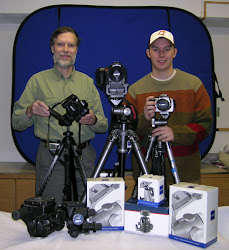The three greatest photo tips of all time as far as photography is concerned include: leading lines, the rule of thirds, and framing. This article will only address one of these, but once you master all three of these, your photography will look better than 90% of all photos out there. Don't believe me? I once did a project where I looked through 200,000 professional stock photos and was only able to find 50 that had mastered all three of these elements.
Centuries ago, Greek artists discovered that the eye tends to focus on certain points in any given image. If you divide your picture into thirds both horizontally and vertically, the points at which those lines intersect are the points where most people focus comfortably. You don't have to draw an arrow, in most cases this is where they will look without any coaching from you or anyone else. This is commonly referred to as the "Rule of Thirds".
By placing your subject (or point of interest) at one of these natural focus points, you have greatly increased the odds that the viewer will indeed be captivated by your work. As you do this more and more; people will notice that for some reason your work seems more interesting than their "Bull's-eye" type snap shot. They won't understand it, but they will be drawn to your work just like a magnet.
The Greeks and Egyptians were great mathematicians. I on the other hand; am not great at math, but I do understand the concept of 1/3rd in from the left or right and 1/3rd up or down. Those who know the formula will argue that it's not exactly 1/3rd, but that's OK. One of the things the rule of thirds does for your image is to give it movement. But wait a minute; you're asking what if my subject isn't moving? That's fine, but it gives your mind somewhere to go with the image. When your subject is dead center, your mind takes one glance and says, "Ok, next." Remember: "It's kind of hard to experience a photograph, if there's nothing left to the imagination."
Even when doing extreme close-ups it is possible to use the rule of thirds. Think of a beautiful models face, what's the first thing you look at? Do you immediately look at the nose? No, I doubt that very much. Usually you either look at the eyes or the lips. Both of these happen to be located where? Both of these heart stopping subjects are located 1/3rd up or 1/3rd down from dead center. Since the nose is usually located dead center; that's why I tend to doubt that it was the first thing that would catch your attention. I'm not saying a person can't have a cute nose, but where it's placed in the picture will determine just how much attention it will get.
Most girls are self conscious about their looks, that's why they tell you to back up. But in reality, that's exactly why you should NOT back up, in fact, you should probably get closer. If you shoot full body on a regular basis, what is usually at 1/3 from the bottom? If a girl is thinking she's fat, you don't want people staring at her waist. Force the viewer to look at her strength's. Draw his attention to her dreamy eyes; or her wonderful smile, not a few extra pounds at her waist.
This same concept works for other subjects besides people. Let's say you have a beautiful stream coming down a mountain side. If you shoot horizontally with the stream dead center, you cut the photo in half. Now in this example, we also have to consider leading lines. If you shoot the stream diagonally and it ends somewhere in the lower left third of the picture, you have still taken advantage of the rule of thirds. This is one of those "professional photo tips" that allows your viewer to experience your photo and not just glance at it.
When you can guide someone into an image and allow them to have an emotional response, your work is much more likely to be remembered. When you use the rule of thirds on a regular basis, you have raised the bar of excellence in such a way that people can not help but to be refreshed and invigorated by your work. If they feel that good just by experiencing your photo once, think how much better they will feel when they start buying your work and enjoying it everyday.
This Article Written By: Tedric A. Garrison Cedar City, Utah
Award winning writer / photographer Tedric Garrison, has 30 years experience in photography. As a Graphic Art Major, he has a unique perspective. His photo eBook "Your Creative Edge" proves creativity can be taught. Today, he shares his wealth of knowledge with the world, at: http://www.betterphototips.com
My Links : Cheap Handbags4u







0 comments:
Post a Comment